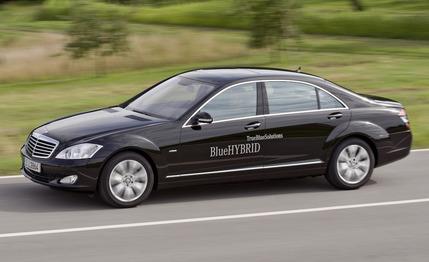
 Mini Test Road Test
Mini Test Road Test
It has taken about 10 years, but European automakers are finally wrapping their heads around the idea that perhaps diesel engines aren’t the only solution to fuel efficiency. Several European automakers are joining in on gasoline-electric hybrid vehicles, once the sole domain of Toyota and Honda. Mercedes-Benz will feature the technology in a luxury car, though the system in the S400 BlueHybrid is unrelated to the two-mode system codeveloped with BMW, Chrysler, and General Motors. For the S-class hybrid, Mercedes is relying on a less complex system developed by Continental Automotive for the S400 BlueHybrid.
Under the hood of the BlueHybrid is Mercedes’ familiar 3.5-liter V-6, modified with new heads, pistons, and camshafts, which boosts power to 275 horsepower. Like many hybrids, the V-6 runs on the Atkinson cycle to improve efficiency. To boost low-end torque and efficiency, the hybrid is equipped with a space-saving, disk-shaped electric motor that also acts as a starter and a generator. The 20-hp electric motor resides in the torque converter housing between the engine and the seven-speed automatic transmission and makes an impressive 118 pound-feet of torque, which is available from rest. The low-end grunt of the electric motor helps the S400 achieve 0-to-60 mph in a claimed 7.2 seconds, which is 0.1 second quicker than the 165-pound-lighter S350 powered by a similar gasoline V-6. Overall weight of the S400 won't likely be much less than that of the 4700-pound S550.
The assist from the electric motor gives the S400 an agile feel and more immediate throttle response, although it doesn't feel as strong as our V-8-powered base S-class, the 382-hp S550. The kick from the electric motor is limited to only about 15 seconds because of the relatively small lithium-ion battery pack, and the electric motor only works up to 4000 rpm. But the boost is useful for low-speed acceleration and even in passing maneuvers. In all other driving situations, the S400 feels pretty much like a conventional S350.
Although the electric motor cannot power the S400 by itself, it does allow the gasoline engine to shut off when slowing to speeds below 9 mph, when coming to a stop, and when idling. When stopped, and with the gasoline engine asleep, the lithium-ion battery powers the accessories such as air conditioning as well as the electro-hydraulic steering. When the driver lifts his foot off the brake pedal, the gasoline engine whirs quickly to life without any hesitation or odd vibrations.
Like all production hybrid vehicles, the electric motor acts as a generator to charge the battery pack during normal cruising or coasting. Hit the brakes lightly, and even more regeneration occurs, charging the battery further. Push harder on the brake pedal, and the conventional disc brakes come into play. Mercedes is correct that drivers won't feel the transition between regenerative braking and conventional braking in the brake pedal but, as with most hybrids, the pedal feel is a bit unnatural and not very linear. Like the Toyota Prius and GM hybrids, the S400 has a display that shows how the power is being diverted, whether the batteries are being charged, and the vehicle’s at-the-moment fuel economy.
The shoebox-size lithium-ion battery pack weighs about 60 pounds, holds up to 0.9 kWh of energy, and sits in the engine compartment where the conventional 12-volt battery that powers the starter usually resides. The underhood electronic control system and the battery pack are cooled by a dedicated cooling system. A small 12-volt lead-acid battery remains mounted in the trunk to power 12-volt systems to reduce the load on the lithium-ion batteries. The net result is a nearly transparent hybrid system that doesn’t reduce passenger or cargo compartments.
According to Mercedes-Benz, the hybrid achieves a 30-mpg European-combined rating, an improvement of 7 mpg over a standard S350. U.S. ratings aren't finalized yet but Mercedes estimates 23 mpg city and 33 mpg highway. That's a huge gain over the S550's 14 mpg city and 22 mpg highway figures.
Europeans will be able to buy the 2010 S400 BlueHybrid starting in June 2009; well-heeled environmentalists in the U.S. can get the car beginning in mid-September. Pricing is likely to hover around that of the S550 model, which cost $91,225 for 2009. Mercedes' 4Matic all-wheel drive will not be available on the S400.